Large-Scale Office Conversion Is an ‘Urban Myth’: Forum
By Keith Loria January 26, 2024 12:23 pm
reprints
Remote work continues to have an extremely negative effect on occupancy of commercial office buildings, particularly in urban areas, as well as on adjacent retailers and restaurants that rely on foot traffic during the day.
This was one of the main takeaways from the recent “What’s The Deal” seminar, sponsored by MacKenzie Companies, which focused on the state of the commercial real estate industry in the Baltimore area.
“The commercial real estate industry is reeling from a confluence of genuinely unique events, including rapidly escalated interest rates, constricted capital flows, work-from-home dynamics, falling values and thin transactional data,” Owen Rouse, senior vice president of MacKenzie Commercial Real Estate Services, said during the seminar. “But the industry has survived difficult times in the past and there is no reason to believe it will not continue to do so.”
Rouse led the discussion together with John Black, president of MacKenzie Capital.
Not surprisingly, the Federal Reserve’s decision to raise interest rates, and the speed of the increases, caused the most damage and enacted the greatest negative impact, according to Rouse.
“All eyes are on the Federal Reserve to see when, and by how much, it will lower interest rates in the coming year,” he said. “After peaking at 5 percent in October, the 10-year Treasury rate is now in the 4 percent range, and though the Fed signaled a pivot point late last year, it has not yet implemented any decreases. The pandemic and its negative impact on the economy lowered interest rates to zero percent, but that was not sustainable and rates remain near historic lows.”
Currently, approximately 20 percent of all commercial office space in the Baltimore City submarket is vacant, and nearly one-half of the city’s empty office space is what Rouse described as “chronically vacant.”
“Conditions are expected to get worse for a period before gradually improving, and certain properties are already in the process of self-repair,” he said. “Conversions of commercial office buildings to multifamily will continue to happen in isolated cases, but expecting this to happen on a large-scale basis is an urban myth.”
One big problem, he pointed out, was that sales of office properties decreased 40 percent last year, which makes it difficult for owners and appraisers to use comparables to establish new prices. That will most likely lead to stagnant activity for at least the first half of 2024.
“There remains a disconnect between buyers and sellers on the pricing of real estate assets, and the market needs to get back to price certainty,” Rouse said. “Competition remains fierce for landlords and owners vying for new office leases, re-tenanting expenses are soaring, and some buildings are facing permanent obsolescence with owners running out of options.”
One positive is that retail remains extremely resilient, and for every tenant that exits a shopping center, there are often two or more companies ready to take the space— especially in retail centers anchored by grocery stores.
“There’s even good news for empty big-box stores: If a large tenant goes dark, owners simply cut the space in half or thirds and lease the space to multiple users, often at higher rents than previously,” Rouse said.
Keith Loria can be reached at Kloria@commercialobserver.com.



